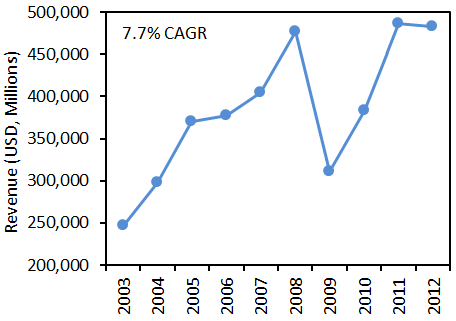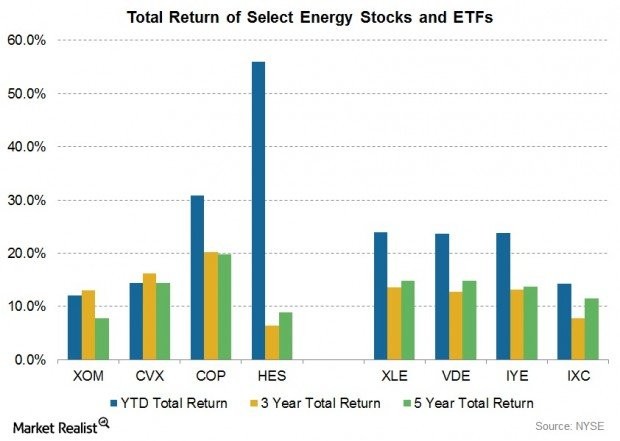Exxon Mobil an Undervalued Dividend Machine
Post on: 5 Июль, 2015 No Comment

A steady payer at a price suggesting a buying opportunity
Exxon Mobil an Undervalued Dividend Machine
Exxon Mobil (XOM ) engages in the exploration and production of crude oil and natural gas, and manufacture of petroleum products, as well as transportation and sale of crude oil, natural gas, and petroleum products. This dividend champion has paid dividends since 1911 and increased distributions on its common stock for 31 years in a row.
The company’s last dividend increase was in April 2013 when the Board of Directors approved a 10.50% increase to 63 cents per share. The company’s largest competitors include Chevron (CVX ), British Petroleum (BP ) and Royal Dutch (RDS.A. RDS.B ). In late 2012, I replaced Exxon Mobil with a position in ConocoPhillips.
Over the past decade this dividend growth stock has delivered an annualized total return of 12.20% to its shareholders.
The company has managed to an impressive increase in annual EPS growth since 2003. Earnings per share have risen by 13.30% per year. Analysts expect Exxon Mobil to earn $8.02 per share in 2013 and $8.21 per share in 2014. In comparison Exxon Mobil earned $9.70 per share in 2012.
Exxon plans to spend $38 billion per year in capital spending over the next five years. The company is targeting over 31 projects, which will deliver 1 million BOE per day by 2017. The major projects that are expected to be brought online include Kashagan Phase 1 project in Kazakhstan, Kearl Oil Sands Project in Canada as well as a few in Africa. Its recent deal with Rosneft to explore in the Arctic and Black seas could generate long-term dividends for the corporation, which has tried to do business in Russia for years.
The company has also tried to increase its exposure to Natural Gas, through its E&P activities as well as the acquisition of XTO Energy three years ago. Unfortunately, natural gas prices have remained in the doldrums, which would affect profitability negatively. In addition, there are few factors that could lead to increase in natural gas prices in the America’s. One bright spot however includes the fact that foreign natural gas prices are more robust than the US ones however.
One important indicator for oil and gas companies is the reserve replacement ratio, which measures the amount of proved reserves added to a companys reserve base during the year relative to the amount of oil and gas produced. Exxon has been successful in maintaining a reserve replacement ratio exceeding 100% in recent years.
Over the past fifteen years, the company has consistently expanded its refining capacity. Refining however is a cyclical business, that is mostly been seen as a cash cow for major integrated producers over the past few years.
Exxon is one of the most consistent repurchasers of stock I have seen, dedicating $5 billion per quarter for this activity. As a result, the number of shares outstanding has decreased from 6.954 billion in 1999 to 4.485 billion in 2013.
However, this has resulted in a stingy dividend payout policy. and below average yields compared to its peers. The company has been able to purchase a large quantity of shares without looking at price, and I have argued that in essence shareholders would have been better off just receiving special distributions. However, in 2012 the company started raising dividends much faster than its peers. Hence, it seems to be changing course, which should bode well for investors.
The return on equity has closely followed the rise and fall in oil and natural gas prices. It rose between 2003 and 2008, and then dipped in 2009, before rebounding strongly. Rather than focus on absolute values for this indicator, I generally want to see at least a stable return on equity over time.

The annual dividend payment has increased by 9% per year over the past decade, which is lower than to the growth in EPS.
A 9% growth in distributions translates into the dividend payment doubling every eight years. If we look at historical data, going as far back as 1974 we see that Exxon Mobil has actually managed to double its dividend every ten years on average.
The dividend payout ratio has remained below 50% for the majority of the past decade. Up until 2011, Exxon Mobil had a stingy dividend payout, where it focused its excess cash flows towards stock buybacks. Starting in 2012 however, the company seems to be changing course, and is increasing distributions much faster than peers. A lower payout is always a plus, since it leaves room for consistent dividend growth minimizing the impact of short-term fluctuations in earnings.
Currently, Exxon Mobil is attractively valued at 9.30 times earnings, yields 2.80% and has an adequately covered dividend. In comparison, peer Chevron trades at 9.10 times earnings and yields 3.40%.
If the amount of attractively valued dividend stocks keeps dwindling, I might initiate a position in Exxon again.
Full Disclosure: Long CVX, COP, RDS.B














